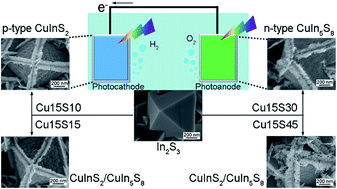Switchable synthesis of p- and n-type Cu–In–S grooved pyramid-like microcrystals for unassisted photoelectrochemical water splitting†
Abstract
Herein, p- and n-type switchable Cu–In–S microcrystals with a grooved pyramid-like morphology are facilely synthesized by transforming binary In2S3. A cation exchange and in situ growth mechanism is proposed to illustrate the generation of grooved pyramid-like Cu–In–S samples. It is demonstrated that the structure, composition, and semiconducting properties of Cu–In–S films could be controlled by maneuvering the rate of cation exchange, which can be simply adjusted by varying the amount of the sulfur precursor. With an increased amount of added thiourea, p-type CuInS2 and n-type CuIn5S8 as well as a mixture of CuInS2 and CuIn5S8 are prepared. The p-type CuInS2 and n-type CuIn5S8 photoelectrodes respectively exhibit a cathodic photocurrent of −0.18 mA cm−2 at −0.4 V vs. RHE and an anodic photocurrent of 0.61 mA cm−2 at 0.7 V vs. RHE in 0.1 M Na2SO4 solution (pH = 3) under AM 1.5G illumination. More importantly, an unassisted water splitting system in parallel mode composed of a CoOx/CuIn5S8 photoanode and a Pt/CuInS2 photocathode is constructed, which shows a photocurrent density of 0.015 mA cm−2. The present work could provide a new idea for constructing efficient unassisted photoelectrochemical water splitting devices using copper-based chalcogenides. Meanwhile, the capability to switch p–n semiconducting properties provides a great inspiration to enable the development of novel semiconductor materials for photoelectric applications.



 Please wait while we load your content...
Please wait while we load your content...